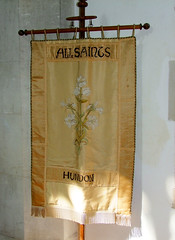| This is a large,
Perpendicular building, finished not long
before the Reformation. No doubt it
enjoyed all the ups and downs of the 17th
Century religious wars, the long 18th
Century sleep of the Church of England,
and the vibrancy and energy of the 19th
Century revival. But it is hard to tell
now, because the church was completely
destroyed by fire one night in February
1914, shortly before the outbreak of the
Great War. There is an excellent display
about this event and its aftermath at the
back of the church, put together by the
children of the village school. The interior successfully
retains a sense of the past, and heavens
be praised the windows are all full of
clear glass. There is plenty of open
space of course, but intriguing little
details - a wheatsheaf salvaged from an
18th Century memorial, the south chancel
aisle panelled with dark wood from the
vicarage, surviving roof timbers forming
a cross in the south aisle.
A wide, light,
simple interior, then, ideally suited for
modern Anglican spirituality. Back in
1851, in the days before the fire, the
Census of Religious Worship counted just
eighty people in the congregation for
morning service out of a population of
more than twelve hundred, barely one in
twelve, a poor turnout even in strongly
non-conformist West Suffolk. And yet the
two independent chapels in the town were
also sparsely populated that morning,
managing barely one hundred and twenty
attenders between them. All three
ministers claimed in their return that
the congregations were ordinarily higher.
You wonder where everybody was that
morning.
|
|
 |

